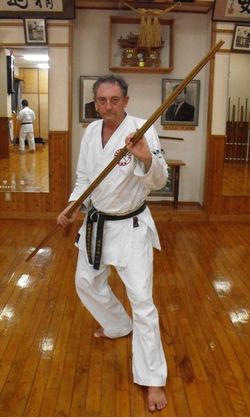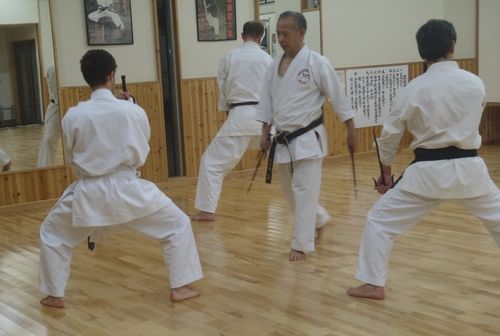CONTRIBUTED BY PENNY VA HEERDEN
In the comments section of my Why Martial Arts? post, someone asked for links to local Martial Arts Association websites. There are so many top notch dojos in Okinawa that I was, at first, a bit hesitant to list only one association. However, since coming to Okinawa I have received so much support and gained so much knowledge from all the people in my association that I decided to share its details with Oki Hai readers.
Okinawa is the birthplace of both Karate and Kobudo (weapons) and as such the quality of both teachers and techniques is the best in the world. If you have even a slight interest in starting martial arts I would recommend you get out into the local community to visit and try a few different dojos. In Okinawa you have tiny hole-in-the-wall dojo to large international associations and everything in between so the main challenge is to find a dojo, teacher, style and association that suits you.
My husband and I train Kobudo and Karate. The style of Karate we train is Shorin Ryu but our main focus is Kobudo, the ancient Okinawan art of using weapons. The two main weapons are the bo and the sai. The bo is a long staff and the sai looks like a large fork with the middle prong much longer than the two side prongs. There are also a variety of other weapons including the nunchaku, tekko, tonfa etc.
Kobudo is a completely separate art from Karate although most Kobudo dojo’s practice Karate as well. In our association any Karate style is welcome and we are represented by Goju Ryu, Shorin Ryu, Uechi Ryu and others. Kobudo gradings are also kept completely separate so even if you have a black belt in your particular Karate style you would still be expected to start your Kobudo training as a white belt. This past week we had a Karate Teacher from the UK who has practiced Karate for the past 41 years. He was just as clumsy with the weapons as any other beginner, which really brought home to me the wisdom of this policy.
 People who have absolutely no experience in Karate are welcome to join the association. Most teachers will teach some Karate basics before allowing new students to pick up a weapon. These basics, such as punching, blocking and stances will help make your weapons training that much easier. When you do pick up a weapon you will be able to concentrate on mastering the use of it rather than worrying about your feet and so on. That is the theory anyway. In practice juggling feet, hands, stance and still using the weapon to perform an effective strike can seem like an insurmountable task in the beginning. Over time with patience from both you and your teacher it becomes second nature and that is the beauty of Kobudo. The sense of accomplishment when you start to see improvement is amazing.
People who have absolutely no experience in Karate are welcome to join the association. Most teachers will teach some Karate basics before allowing new students to pick up a weapon. These basics, such as punching, blocking and stances will help make your weapons training that much easier. When you do pick up a weapon you will be able to concentrate on mastering the use of it rather than worrying about your feet and so on. That is the theory anyway. In practice juggling feet, hands, stance and still using the weapon to perform an effective strike can seem like an insurmountable task in the beginning. Over time with patience from both you and your teacher it becomes second nature and that is the beauty of Kobudo. The sense of accomplishment when you start to see improvement is amazing.
Our particular association doesn’t encourage free sparring with weapons as injuries are too frequent and can be severe. However, we do have Yakusoku Kumite. Yakusoku means promise and kumite means sparring. In the bo against bo sparring there are twelve sets of attacks and defenses. In each set one person will attack and their opponent will perform a defense and counter-attack. In this way students develop focus and learn the meaning of the moves they practice as basics as well as in the kata forms. As both people know the sequence chances of injury is reduced and control, especially by the more advanced partner, is expected.
Anyone interested in learning more about Kobudo and our particular association, Ryukyu Kobudo Hozon Shinko Kai can visit the official website at the link found after the article. The head dojo of the association is located in Tomigusuku just south of Naha City. Akamine Sensei, the head of the association, speaks excellent English and is used to teaching foreigners from all over the world, including UK, India, Australia etc. We also have a branch dojo located in Chatan which is probably more convenient for most readers of Okinawa Hai. They teach Uechi Ryu Karate and Kobudo. There are a few foreign students that practice at the dojo although Arakaki Sensei speaks better Spanish than he does English. Details of the Chatan Chibu Dojo and address can be found on the dojo listing on the website.
Please contact the sensei’s before visiting so they will be prepared to meet with you.
If anyone has any questions about the association feel free to contact the webmaster who also happens to be my husband, Emile van Heerden. We look forward to seeing a few new faces in the dojo.
For an overview of our association go here.
For a list of both local and international dojos go here.




hi, sensei i from india and i was participated international ryukyu kobudo championship in August 2009 in okinawa . I won bronze medal and certificate received from Hanshi Hiroshi Akamine and also who teaches karate and kobudo to me in hombu dojo in okinawa after came to india misunderstanding with our sensei krishnamoorthy i went out to join shorinryu shorinkan till date i am practicing there now i want to learn ryukyu kobudo what can i do. please reply to me sensei.
Hi,
I was wondering where you are training in shorin ryu (and which branch of shorin is yours) ?
Best.
Been a while since I wrote this article. I apologise for not updating the information sooner. Unfortunately the Chatan dojo mentioned in the article has also split from the new Shimbukan Association. As such the only dojo currently in Okinawa is the Hombu Dojo in Tomigusuku as well as one on Kume Island.
Look for a list of dojo here http://ryukyu-kobudo.com/dojo/
The karate I do is Shorin Ryu Mukenkai. Akamine Sensei is the head of this association as well and it is a fairly small association in Okinawa.
The website is currently undergoing a rewrite again as our webmaster left the association so I apologise if any links don’t work properly. Despite the upheavals in this association I still encourage all foreigners to get into a local dojo to experience Karate or Kobudo in their birthplace.
Hi Angelina,
So sorry you can’t view the dojo listings. Since the association changed names the website has been rewritten. The new URL is http://ryukyu-kobudo.com/members_dojo/kobudo_dojo_list.php There is a dojo in Chatan. I think it is in Hamby Town but I will try to get directions for you.
I can’t view the listing of Dojo’s on my computer.
Is there any dojo’s close to Camp Foster??
Thanks for the info.
Basically, it was a case of politics getting in the way of Akamine Sensei’s enjoyment of his art. He decided that he and his family would be better off if he was able to focus on doing what he loves rather than dealing with administrative problems.
It was sad but I think, a necessary change for him.
Hi Sensei Penny I was wondering why did Akamine Sensei Resign from The Hozon Shinko Kai ??
Hi there, well the publishing of this article turned out to be a bit of bad luck. On July 1st Akamine Sensei resigned from Ryukyu Kobudo Hozon Shinko Kai and started his own association now named Ryukyu Kobudo Shimbukan. At present the above website is being redesigned so the links may not always be working properly. Sincere apologies for that. The problem should soon be rectified and I hope that anybody interested in learning kobudo will be patient. The good news is that Arakaki Sensei of the Chatan dojo has moved with Akamine Sensei as have most of the overseas students.